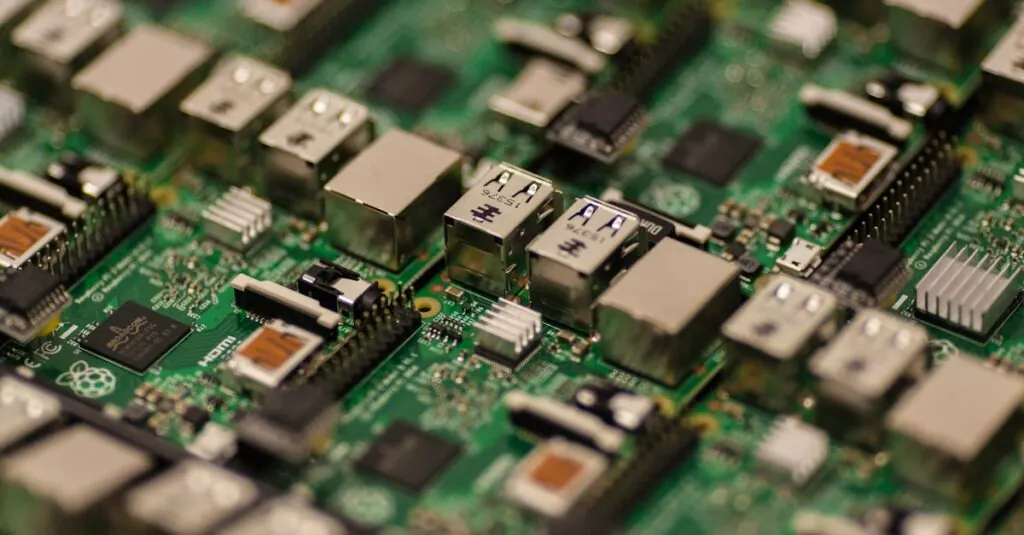Table of Contents
ToggleBreadboards: the unsung heroes of the electronics world. They’re like the playgrounds where circuits come to life without the need for a permanent commitment. Whether you’re a seasoned engineer or a curious newbie, mastering breadboard configurations can turn your wildest electronic dreams into reality—without the risk of shocking your cat.
Overview Of Breadboard Configurations
Breadboard configurations enable flexible circuit design and testing. Understanding different layouts enhances the ability to create complex circuits without soldering.
Two common configurations exist: the power rail and the terminal strip. The power rail provides a continuous source of voltage, making it easy to connect multiple components. Each rail typically accommodates positive and negative voltage to streamline connections.
The terminal strip contains rows of interconnected pins. In many designs, interconnected pins simplify circuit assembly. Each horizontal row connects several pins, enabling quick and easy access to various components.
Using a standard breadboard configuration offers advantages in experimentation. A prototyping arrangement aids in identifying and addressing design flaws. Set up a simple circuit to verify functionality before committing to a permanent solution.
Complex projects often require custom configurations. Engineers rearrange components to fit specific project needs. They may employ multiple breadboards for substantial projects to manage connections efficiently.
Optimizing space within the breadboard is crucial. Placing components strategically minimizes clutter and enhances accessibility. Detailed labeling of connections can further streamline identifying circuits.
Breadboard configurations play a pivotal role in electronic prototyping. Mastery of these arrangements leads to more effective experimentation and innovation in circuit design. Each configuration caters to unique project requirements, allowing for versatility in electronic exploration.
Types Of Breadboard Configurations
Understanding different breadboard configurations enhances the efficiency of circuit design and experimentation. Several arrangements provide specific advantages based on project requirements.
Standard Breadboard Configuration
Standard breadboard configurations consist of a surface with rows of interconnected holes, facilitating easy connections. These boards typically feature power rails on the top and bottom, supplying voltage and ground. Terminal strips run vertically in the center, allowing for straightforward wiring of components. Utilization of this layout supports rapid prototyping and simplifies troubleshooting. Connecting multiple components quickly becomes feasible, making it ideal for beginners and experienced users alike. This structure promotes clarity and accessibility during circuit testing.
Vertical Breadboard Configuration
Vertical breadboard configurations present an alternative layout that enhances space efficiency. Arranging components vertically maximizes the use of available board space, which often accommodates larger projects. This orientation enables users to stack components, promoting better organization. Easy access to connections remains intact while maintaining a clean appearance. Utilizing separate vertical sections for different circuit parts improves identification and debugging processes. Ultimately, this configuration encourages creative circuit designs without sacrificing functionality.
Horizontal Breadboard Configuration
Horizontal breadboard configurations offer a unique way to assemble circuits. This layout positions components horizontally, allowing for longer connections between them. A user can create extended circuits without introducing excess clutter. Components align neatly, supporting efficient organization and minimizing the risk of short circuits. Typically seen in expansive projects, this approach simplifies testing of large-scale designs. Consequently, clearer paths establish a better workflow for designing and verifying circuit functionality.
Advantages Of Using Breadboard Configurations
Breadboard configurations offer significant advantages in circuit design and experimentation for both beginners and experienced engineers. Their flexible nature provides a valuable platform for creating and modifying circuits quickly.
Flexibility In Prototyping
Prototyping with a breadboard allows for rapid adjustments during the design process. Configuration changes can occur without soldering, enabling quick tests and iterations. Designers can swap out components easily, which promotes creativity and exploration. Also, layouts can adapt to different project requirements, enhancing versatility. This flexibility encourages engineers to experiment freely and discover optimal solutions.
Ease Of Use And Accessibility
Breadboards simplify the overall assembly of complex electronic circuits. Their intuitive layout makes it easy to connect components without in-depth technical knowledge. Power rails and terminal strips create organized pathways, ensuring that connections are clear and accessible. With a standardized format, newcomers can quickly understand the basics of circuit assembly. Additionally, the transparent design allows visibility of connections, which aids in troubleshooting and learning. Easy adjustments support ongoing education and practice in electronic projects.
Best Practices For Setting Up Breadboard Configurations
Setting up breadboard configurations effectively enhances circuit experimentation and design. Adhering to best practices ensures ease of use and functionality.
Component Placement Tips
Place components with clear organization in mind. Position similar parts close together to simplify connections. Consider using a systematic approach to layout for easy identification and access. Keep power supply connections on the outer rows of the breadboard to minimize interference and clutter. Use different colors for wires to distinguish between power and ground connections visually. Maintain consistent spacing between components to prevent accidental short circuits. Group components like resistors and capacitors logically, aiding in quick troubleshooting during circuit tests.
Circuit Design Considerations
Designing circuits requires attention to detail. When building, prioritize simplicity for better manageability and troubleshooting. Choose components that fit well within the breadboard’s layout, ensuring adequate space for connections. Reserve designated areas for power and ground lines, enhancing clarity in larger projects. Keep in mind the length of connections; shorter wire lengths help reduce resistance and maintain signal integrity. Recognize the importance of testing circuit functionality at each stage to catch errors early in the process. Design with adaptability in mind to facilitate modifications as projects evolve.
Conclusion
Understanding breadboard configurations is vital for anyone involved in electronics. These configurations not only streamline the prototyping process but also foster creativity and innovation. By mastering the different layouts such as standard, vertical, and horizontal, users can optimize their designs and improve accessibility.
Implementing best practices in circuit assembly enhances clarity and minimizes errors. This approach empowers both beginners and seasoned engineers to experiment confidently. Ultimately, effective use of breadboard configurations paves the way for successful electronic projects and encourages ongoing learning in the field.




